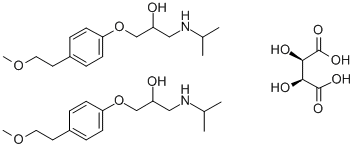-
Name
(+-)metoprolol-(+)tartrate
- EINECS 260-148-9
- CAS No. 56392-17-7
- Article Data4
- CAS DataBase
- Density 1.1946 (rough estimate)
- Solubility Soluble in water (>1000 mg/ml), methanol (>500 mg/ml), chloroform (496 mg/ml), ethanol (31 mg/ml at 25°C), and DMSO (100 mg/ml at 25°C).
- Melting Point 120oC
- Formula 2(C15H25NO3).(C4H6O6)
- Boiling Point 398.6 °C at 760 mmHg
- Molecular Weight 684.825
- Flash Point 194.9 °C
- Transport Information
- Appearance crystalline powder
- Safety 7-16-36/37-45-24/25
- Risk Codes 11-23/24/25-39/23/24/25
-
Molecular Structure
- Hazard Symbols F,T
- Synonyms Metoprolol-(+,-) (+)-tartrate salt;2-Propanol,1-[4-(2-methoxyethyl)phenoxy]-3- [(1-methylethyl)amino]-,(2R,3R)-2,3- dihydroxybutanedioate (2:1) (salt);Betaloc;Beloc;Seloken;Lopressor;Metoprolol tartrate (JAN/USP);Lopresor;(2R,3R)-2,3-dihydroxybutanedioic acid; 1-[4-(2-methoxyethyl)phenoxy]-3-(propan-2-ylamino)propan-2-ol;Prestwick_1009;2,3-dihydroxybutanedioic acid; 1-[4-(2-methoxyethyl)phenoxy]-3-(propan-2-ylamino)propan-2-ol;Lopressor (TN);Metoprolol tartaric acid;
- PSA 216.50000
- LogP 1.88560
Metoprolol tartrate Specification
1. Introduction of Metoprolol tartrate
Metoprolol tartrate is also named as 2-Propanol, 1-(isopropylamino)-3-(p-(2-methoxyethyl)phenoxy)-, (+-)-, tartrate (2:1). With the classification codes of Anti-adrenergic [beta-receptor]; Drug/Therapeutic Agent; Human Data; Reproductive Effect, its product categories are Cardiovascular; Amines; Aromatics; Intermediates & Fine Chemicals; Pharmaceuticals; Adrenoceptor. Additionally, keep this chemical in the cool and dry place where the room is ventilated.
2. Properties of Metoprolol tartrate
Other characteristics of the Metoprolol tartrate can be summarised as followings: (1)ACD/LogP: 1.79; (2)# of Rule of 5 Violations: 0; (3)#H bond acceptors: 4; (4)#H bond donors: 2; (5)#Freely Rotating Bonds: 10; (6)Polar Surface Area: 30.93 Å2; (7)Flash Point: 194.9 °C; (8)Enthalpy of Vaporization: 68.47 kJ/mol; (9)Boiling Point: 398.6 °C at 760 mmHg; (10)Vapour Pressure: 4.52E-07 mmHg at 25°C.
3. Structure Descriptors of Metoprolol tartrate
1) SMILES: O=C(O)[C@H](O)[C@@H](O)C(=O)O.O(c1ccc(cc1)CCOC)CC(O)CNC(C)C.O(C)CCc1ccc(OCC(O)CNC(C)C)cc1
2) InChI: InChI=1/2C15H25NO3.C4H6O6/c2*1-12(2)16-10-14(17)11-19-15-6-4-13(5-7-15)8-9-18-3;5-1(3(7)8)2(6)4(9)10/h2*4-7,12,14,16-17H,8-11H2,1-3H3;1-2,5-6H,(H,7,8)(H,9,10)/t;;1-,2-/m..1/s1
3) InChIKey:YGULWPYYGQCFMP-CEAXSRTFBA
4. Toxicity of Metoprolol tartrate
| Organism | Test Type | Route | Reported Dose (Normalized Dose) | Effect | Source |
|---|---|---|---|---|---|
| dog | LD50 | oral | 1090mg/kg (1090mg/kg) | Iyakuhin Kenkyu. Study of Medical Supplies. Vol. 14, Pg. 297, 1983. | |
| human | TDLo | oral | 160mg/kg (160mg/kg) | CARDIAC: PULSE RATE VASCULAR: BP LOWERING NOT CHARACTERIZED IN AUTONOMIC SECTION LUNGS, THORAX, OR RESPIRATION: CYANOSIS | British Medical Journal. Vol. 1, Pg. 222, 1976. |
| mouse | LD50 | intraperitoneal | 202mg/kg (202mg/kg) | Gekkan Yakuji. Pharmaceuticals Monthly. Vol. 24, Pg. 2439, 1982. | |
| mouse | LD50 | intravenous | 84mg/kg (84mg/kg) | Drugs in Japan Vol. -, Pg. 614, 1995. | |
| mouse | LD50 | oral | 1500mg/kg (1500mg/kg) | BEHAVIORAL: SOMNOLENCE (GENERAL DEPRESSED ACTIVITY) BEHAVIORAL: CONVULSIONS OR EFFECT ON SEIZURE THRESHOLD | Kiso to Rinsho. Clinical Report. Vol. 13, Pg. 2839, 1979. |
| mouse | LD50 | subcutaneous | 510mg/kg (510mg/kg) | BEHAVIORAL: SOMNOLENCE (GENERAL DEPRESSED ACTIVITY) BEHAVIORAL: CONVULSIONS OR EFFECT ON SEIZURE THRESHOLD | Kiso to Rinsho. Clinical Report. Vol. 13, Pg. 2839, 1979. |
| rabbit | LD50 | intravenous | 28700ug/kg (28.7mg/kg) | Iyakuhin Kenkyu. Study of Medical Supplies. Vol. 14, Pg. 297, 1983. | |
| rabbit | LD50 | oral | 604mg/kg (604mg/kg) | Iyakuhin Kenkyu. Study of Medical Supplies. Vol. 14, Pg. 297, 1983. | |
| rat | LD50 | intraperitoneal | 219mg/kg (219mg/kg) | Gekkan Yakuji. Pharmaceuticals Monthly. Vol. 24, Pg. 2439, 1982. | |
| rat | LD50 | intravenous | 90mg/kg (90mg/kg) | BEHAVIORAL: SOMNOLENCE (GENERAL DEPRESSED ACTIVITY) LUNGS, THORAX, OR RESPIRATION: RESPIRATORY STIMULATION | Kiso to Rinsho. Clinical Report. Vol. 13, Pg. 2839, 1979. |
| rat | LD50 | oral | 5500mg/kg (5500mg/kg) | BEHAVIORAL: ALTERED SLEEP TIME (INCLUDING CHANGE IN RIGHTING REFLEX) BEHAVIORAL: SOMNOLENCE (GENERAL DEPRESSED ACTIVITY) BEHAVIORAL: CONVULSIONS OR EFFECT ON SEIZURE THRESHOLD | Kiso to Rinsho. Clinical Report. Vol. 13, Pg. 2839, 1979. |
| rat | LD50 | subcutaneous | 1150mg/kg (1150mg/kg) | BEHAVIORAL: ALTERED SLEEP TIME (INCLUDING CHANGE IN RIGHTING REFLEX) BEHAVIORAL: SOMNOLENCE (GENERAL DEPRESSED ACTIVITY) BEHAVIORAL: CONVULSIONS OR EFFECT ON SEIZURE THRESHOLD | Kiso to Rinsho. Clinical Report. Vol. 13, Pg. 2839, 1979. |
5. Preparation of Metoprolol tartrate
The 4-(2-methoxyethyl) phenol reacts with Chloro-propylene oxide, and its product reacts with isopropylamine in the existence of isopropanol. Finally the Metoprolol tartrate is obtained when heated at about 100 °C.
.jpg)

6. Use of Metoprolol tartrate
The Metoprolol tartrate, incompatible with strong oxidizing agents, is used in the treatment of a variety of cardiovascular disorder. It's a selective adrenergic beta-1-blocking agent with no stimulatory action. It's binding to plasma albumin is weaker than alprenolol and it may be useful in angina pectoris, hypertension, or cardiac arrhythmias.
Related Products
- Metoprolol
- Metoprolol tartrate
- 56394-22-0
- 56394-28-6
- 563-96-2
- 56396-30-6
- 56396-63-5
- 56400-88-5
- 56401-20-8
- 56401-88-8
- 56403-12-4
- 56403-29-3
Hot Products
About|Contact|Cas|Product Name|Molecular|Country|Encyclopedia
Message|New Cas|MSDS|Service|Advertisement|CAS DataBase|Article Data|Manufacturers | Chemical Catalog
©2008 LookChem.com,License: ICP
NO.:Zhejiang16009103
complaints:service@lookchem.com Desktop View